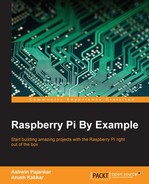Book Description
Start building amazing projects with the Raspberry Pi right out of the box
About This Book
- Explore the vast range of opportunities provided by Raspberry Pi and other hardware components such as a webcam, the Pi camera, and sensors
- Get hands-on experience with coding, networking, and hardware with the Raspberry Pi platform
- Learn through ample screenshots that offer a play-by-play account of how to implement Raspberry-Pi-based real-life projects
Who This Book Is For
What's the best way to learn how to use your Raspberry Pi? By example! If you want something exciting to do whilst getting to grips with what your Pi can offer, this is the book for you. With both simple and complex projects, you'll create a wide variety of cool toys and functions with your Raspberry Pi - all with minimal coding experience necessary.
What You Will Learn
- Set up your Raspberry Pi and get it ready for some interesting real-life projects
- Work with images, videos, webcams, and the Pi camera and create amazing time-lapse videos
- Explore the amazing world of Minecraft Pi
- Get to know how to use PiGlow for GPIO programming
- Interface your Pi with Grove Sensors and implement IoT applications
- Build your own cluster with Raspberry Pi
- Understand the networking and network programming fundamentals
In Detail
Want to put your Raspberry Pi through its paces right out of the box? This tutorial guide is designed to get you learning all the tricks of the Raspberry Pi through building complete, hands-on hardware projects. Speed through the basics and then dive right in to development!
Discover that you can do almost anything with your Raspberry Pi with a taste of almost everything. Get started with Pi Gaming as you learn how to set up Minecraft, and then program your own game with the help of Pygame. Turn the Pi into your own home security system with complete guidance on setting up a webcam spy camera and OpenCV computer vision for image recognition capabilities. Get to grips with GPIO programming to make a Pi-based glowing LED system, build a complete functioning motion tracker, and more. Finally, get ready to tackle projects that push your Pi to its limits. Construct a complete Internet of Things home automation system with the Raspberry Pi to control your house via Twitter; turn your Pi into a super-computer through linking multiple boards into a cluster and then add in advanced network capabilities for super speedy processing!
Style and approach
This step-by-step guide to building Raspberry-Pi-based projects is explained in a conversational and easy-to-follow style. Each topic is explained sequentially in the process of creating real-life projects, and detailed explanations of the basic and advanced features of various Python libraries are also included.
Downloading the example code for this book. You can download the example code files for all Packt books you have purchased from your account at http://www.PacktPub.com. If you purchased this book elsewhere, you can visit http://www.PacktPub.com/support and register to have the code file.
Table of Contents
- Raspberry Pi By Example
- Table of Contents
- Raspberry Pi By Example
- Credits
- About the Authors
- About the Reviewers
- www.PacktPub.com
- Preface
- 1. Introduction to Raspberry Pi and Python
- 2. Minecraft Pi
- 3. Building Games with PyGame
- 4. Working with a Webcam and Pi Camera
- 5. Introduction to GPIO Programming
- 6. Creating Animated Movies with Raspberry Pi
- 7. Introduction to Computer Vision
- Introducing Computer Vision
- Introducing OpenCV
- Setting up Pi for Computer Vision
- Introducing NumPy
- Working with images
- Working with Webcam using OpenCV
- Retrieving image properties
- Arithmetic operations on images
- Splitting and merging image color channels
- Logical operations on images
- Colorspaces and conversions
- Tracking in real time based on color
- Summary
- 8. Creating Your Own Motion Detection and Tracking System
- 9. Grove Sensors and the Raspberry Pi
- 10. Internet of Things with the Raspberry Pi
- 11. Build Your Own Supercomputer with Raspberry Pi
- Introducing a Pi-based supercomputer
- Installing and configuring MPICH2 and MPI4PY
- Setting up the Raspberry Pi cluster
- Setting up SSH access from the host to the client
- Running code in parallel
- Performance benchmarking of the cluster
- Introducing N-Body simulations
- Installing and running GalaxSee
- Summary
- 12. Advanced Networking with Raspberry Pi
- 13. Setting Up a Web Server on the Raspberry Pi
- 14. Network Programming in Python with the Pi
- A. Newer Raspberry Pi Models
- Index
